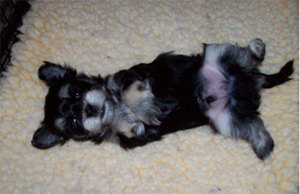
At about three weeks from the date of mating, morning sickness might occur due to hormonal changes or stretching and distension of the uterus. The dam may appear a bit apathetic. She may be off her feed for a while and vomit from time to time. Feeding the dam several meals spaced throughout the day might help.
At four weeks, start to increase the dams food ration. Don’t overfeed; excessive weight gain should be avoided.
Evidence of Pregnancy
An experienced veterinarian or breeder can detect fetuses by palpating the dam’s abdomen about 26 to 30 days after breeding has taken place. At this stage the embryos are the size of almonds and are distributed symmetrically along the dam’s uterine horns. After day 30 the embryos are difficult to palpate individually as they enlarge and become surrounded by fluids.
After day 30 an ultrasound can be used to confirm pregnancy, however ultrasound will not result in an accurate puppy count.
Movement of the puppies can often be felt by day 55 after breeding. The pups are often quiet while the dam is active, and can be felt more easily when the dam is at rest. Again, an accurate puppy count cannot be determined by feeling the puppies movement.
Radiographs can accurately indicate the number of puppies after day 55 of breeding. The position of the puppies can also be determined. Prior to day 55 the puppies’ bones may not have calcified, and thus may not show up on x-rays. As with all procedures
 performed on the dam, consult your eterinarian regarding the safety of these measures.
performed on the dam, consult your eterinarian regarding the safety of these measures.There are other indications that your dam is pregnant, however they can also occur in dams experiencing a false pregnancy. These signs include an enlarged abdomen, enlarged nipples containing fluid, morning sickness, loss of hair on her abdomen and around her nipples, vaginal discharge and nesting behavior.
For an example of an online pregnancy calendar, go to the German Shepherd Information Source – Copyright © reprinted by permission.
